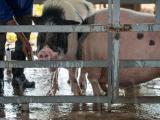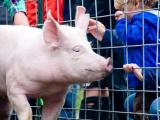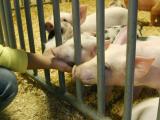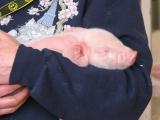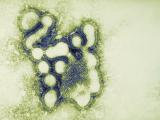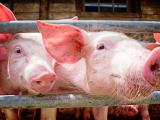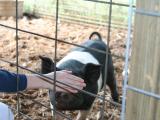Sep 2, 2011 (CIDRAP News) – In separate instances, influenza A/H3N2 viruses circulating in swine picked up a gene from the pandemic 2009 H1N1 virus and recently infected two young children, one in Indiana and one in Pennsylvania, the Centers for Disease Control and Prevention (CDC) reported today.
Both of the children recovered, though one was briefly hospitalized, and there is no sign that the viruses spread from the children to others, but any evidence of ongoing transmission would require a rapid response, the CDC said.
The agency also said one of the children had no direct contact with pigs, which suggests he caught it from another person. Both children are under age 5.
The two viruses are similar to eight other swine-origin H3N2 viruses found in humans in the past 2 years, but they are unique in that they contain the matrix (M) gene from the 2009 H1N1 virus, the CDC reported in an early online posting in Morbidity and Mortality Weekly Report (MMWR). The two viruses are similar but not identical.
"I don't think these [viruses] have pandemic potential; it looks like both of these are sort of dead-end transmissions," Lyn Finelli, DrPH, chief of the surveillance and outbreak response team in the CDC's influenza division, told CIDRAP News.
But she also commented, "One of the reasons we publish this data is that reassortment happens in swine viruses and in humans, so we always want to have surveillance in place so we can detect the next emerging reassortant. Viruses like these do have pandemic potential."
Though no further cases have been found, the report says, "If additional chains of transmission are identified rapid intervention is warranted [to] try to prevent further spread of the virus."
Case details
The first case involved an Indiana boy who got sick with a fever, cough, shortness of breath, diarrhea, and sore throat on Jul 23, the report says. He was seen at a hospital emergency department (ED) and was sent home without receiving antiviral treatment; a respiratory sample taken during the visit later tested positive for influenza A/H3. The boy, who has chronic health conditions, returned to the ED Jul 24 and was hospitalized for treatment of those conditions. He was released Jul 27 and has since recovered.
A specimen from the boy was sent to the Indiana state public health laboratory as part of routine surveillance, and a suspected swine-origin H3N2 virus was identified on Aug 17. The lab sent the specimen to the CDC, which used genome sequencing to confirm the finding Aug 19.
The boy had had no direct exposure to pigs, but a person who took care of him 2 days before he got sick reported direct contact with apparently healthy pigs in the preceding weeks. The CDC said this suggests that the virus might have spread from the caretaker to the boy. Investigators found no respiratory illness in the boy's family or close contacts or the caretaker's contacts.
In the second case, a girl in Pennsylvania experienced a fever, cough, and lethargy on Aug 20 and was taken to a local ED, where a rapid flu test was positive for influenza A. She was sent home the same day without receiving antiviral treatment and has since recovered, the report says.
In routine surveillance, samples from the girl were sent to Pennsylvania's state health department lab, which identified a suspected swine-origin H3N2 virus and forwarded the samples to the CDC. The agency confirmed the finding on Aug 26.
The girl on Aug 16 had visited a fair, where she was exposed to pigs and other animals. No illnesses have been found among the girl's family or close contacts, according to the report. Finelli said the CDC is also checking for illnesses among others who attended the fair, but has found none so far.
Children more susceptible
The fact that both patients were children may be related to the recent history of H3N2 virus circulation, according to Finelli. She said most of the swine flu human infections reported in recent years have been in children, with a median age of 10 or 11.
"The H3N2 that circulated in humans before 1990 was a relative of this [new] virus," so people exposed at that time would have some cross-reactive immunity to the new strain, she explained. "So people under 20 are probably more susceptible than people that are older."
The report says seven of the eight gene segments in the two viruses are similar to those of swine H3N2 viruses that have circulated in US pigs since 1998 and were identified in eight other human cases of swine-origin flu since 2009. But the two viruses contain the M gene from the 2009 H1N1 virus, which has previously been identified in pigs a few times. This particular combination of genes had not been reported previously in pigs or humans, the CDC said.
Finelli noted that flu viruses are common in pigs in the United States and worldwide. Between 50% and 90% of mature pigs (about 2 years and older) have antibodies signifying exposure to flu viruses, and there are flu outbreaks in swine herds every year, she said.
"Different viruses are circulating simultaneously among pigs—this virus being one of those," she said. But she said she has no idea how common this particular reassortant might be.
Reports of human infections with swine-origin flu viruses have increased in recent years, at least partly because of increased testing and reporting, according to the report. The CDC received about one report per year from 2005 to 2007. In 2007 infection with novel influenza A viruses became a nationally notifiable condition, and since then the CDC has received about three to five reports of swine-origin viruses in humans each year.
In 2004 and 2005, state health departments received CDC money to run polymerase chain reaction tests on uncommon flu strains, Finelli said. "Because of the new requirement to report and new technologies to test viruses, we have sort of a confluence of events that makes these more likely to be reported," she commented. "We do hear of about four or five of these cases every year, and they're often around state and county fair time."
The two new viruses are resistant to the older flu drugs, amantadine and rimantadine, but susceptible to oseltamivir (Tamiflu) and zanamivir (Relenza), the CDC report says.
Finelli said she didn't find it surprising that the two children were not treated with antivirals. "The reason it's not [surprising] is that this is not flu season, though these clinicians were very smart to get samples from the kids. People don't expect flu to be circulating now, so they don't treat empirically with antivirals. This is one of the reasons we put out this piece. We want them to sample and we want them to treat empirically."
Andrew T. Pavia, MD, chief of the Division of Pediatric Infectious Diseases at the University of Utah in Salt Lake City, told CIDRPA News via e-mail that the CDC report "should serve as a reminder that new reassortants can emerge at any time and any place. I don't think we can safely say that the 2009 H1N1 pandemic reset the clock and guarantees a long period of calm before the next storm."
"Pigs continue to play a very important role in flu epidemiology, and we need to have a good surveillance system for viruses emerging in swine agriculture," Pavia added. "This can be a challenge both because of threatened funding cuts and because of sensitivity within the industry."
He called the cases noteworthy but not alarming. "We need to wait and see if either strain has spread. We would not predict that addition of the matrix segment from H1N1 would make a swine H3N2 that spreads poorly in people have pandemic potential BUT our ability to predict is not great. A different reassortant might easily arise from mixing human, pig, and bird segments with the capacity to be dangerous, either because of a new H [hemagglutinin] type or because of high level antiviral resistance."
CDC. Swine-origin influenza A (H3N2) virus infection in two children—Indiana and Pennsylvania, July-August 2011. MMWR 2011 Sep 2 (Early release) [Full text]
